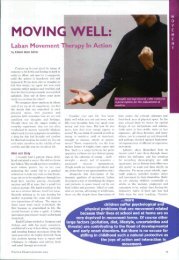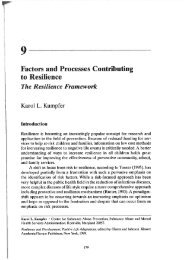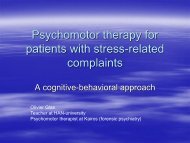Solution-Focused Brief Therapy With Long-Term Problems
Solution-Focused Brief Therapy With Long-Term Problems
Solution-Focused Brief Therapy With Long-Term Problems
You also want an ePaper? Increase the reach of your titles
YUMPU automatically turns print PDFs into web optimized ePapers that Google loves.
Simon & Berg SFBT <strong>With</strong> <strong>Long</strong> <strong>Term</strong> <strong>Problems</strong> Page 4<br />
__________________________________________________________________________________________<br />
new experience for most of them. Even with<br />
careful pacing and connecting with clients, the<br />
common immediate response frequently begins<br />
with, “I don’t know. . . I suppose, I will be calmer,<br />
relaxed . . . like I could face the day. . .” It is<br />
important to track the client’s solution picture in<br />
detail.<br />
In the course of asking solution-building<br />
questions, quite often the client will raise<br />
exceptions, times that the problem either is<br />
experienced as less significant or absent entirely.<br />
When the therapist hears this, it is usually helpful<br />
to expand on exceptions. 3,8,9 In the course of<br />
discussing the Miracle Question, solution-focused<br />
therapists might ask the client about exceptions<br />
directly. For example, “What part of the miracle<br />
is already happening?”<br />
Once the client details his or her miracle<br />
picture, the solution-focused therapist will ask a<br />
Scaling Question. 3,8,9 Scaling Questions not only<br />
help the client to recognize exceptions, but begin<br />
the process of defining the “next steps.” The<br />
typical scaling question requests the person to<br />
place oneself on a scale from 0 to 10, where 0 is<br />
the least desired condition, and 10 is the most<br />
desired outcome. Scaling possibilities are<br />
unlimited and many different types of scales can<br />
be used: for example, miracle day scales,<br />
confidence scales, motivation scales, or even<br />
safety scales. Scaling possibilities are limited<br />
only by the therapist’s creativity and the<br />
applicability to the client.<br />
When using scales, the solution-focused<br />
therapist will discuss what the particular number<br />
means to the client. The question is always in<br />
terms of how the client got up to the number on<br />
the scale rather than why the number is not higher.<br />
For example, if a client tells us that he or she is at<br />
3 on the scale, we might ask, “How is 3 different<br />
from 0,” or, “How did you go all the way up to<br />
3?”<br />
After the meaning of the specific scale<br />
number is negotiated, the solution-focused<br />
therapist will then ask how the client will know<br />
when he or she is just one number higher on the<br />
scale. This next step is discussed in detail; we<br />
want to know what will be different for the client<br />
and how other people will know when the next<br />
step is reached. We also ask what difference that<br />
next step t will make for the client as well as<br />
others within his or her social environment.<br />
Pre-session, vision of the future, miracle,<br />
exception and scaling questions will be useful<br />
with the majority of clients. Occasionally, a<br />
client may have initial difficulty thinking beyond<br />
the problem situation and is unable to shift into a<br />
solution-building context. At these time, we find<br />
it useful to ask clients coping questions. 3,8,9 For<br />
example, “Given everything you have told me<br />
about what’s going on in your life, how do just<br />
make it through each day?” We find that most<br />
often the client will respond with a strength based<br />
response. The solution-focused therapist can then<br />
expand on that response. For example, in<br />
response to a coping question the client might say,<br />
“My mother taught me how to be strong.” The<br />
therapist would respond, “What would your<br />
mother see you doing now that would tell her that<br />
you’re being strong?”<br />
As solution-focused therapists, we employ<br />
the six questions appropriately in order to gauge<br />
the client’s response. To be truly helpful to the<br />
client, the therapist must practice careful listening.<br />
We find it most helpful to weave our next<br />
questions in response to the client’s key words.<br />
For example, when a client says, “I won’t be<br />
ashamed of myself anymore,” we might use the<br />
client’s key words and ask, “So, when you are no<br />
longer ashamed, what would you feel instead?”<br />
As the therapist develops listening skills to<br />
facilitate this kind of conversation, he or she<br />
begins to become aware of a wealth of<br />
possibilities, each one having the potential of<br />
moving the session in useful ways. The therapist<br />
needs to really listen to what the client says and<br />
not assume anything.<br />
At this point in the session, the therapist<br />
will take a break. If working with a group of<br />
colleagues behind a one-way mirror or video<br />
monitor, the therapist will discuss the client. If<br />
working alone, he or she will take time to think<br />
about what the client said during the interview.<br />
When the session resumes, the therapist will relate<br />
what he or she and/or the team thinks. Campbell,<br />
Elder, Gallagher, Simon, and Taylor 10 characterize<br />
the message as compliments. The authors<br />
summarize this compliment process:<br />
The compliments usually include<br />
validation of concerns, recognition of













